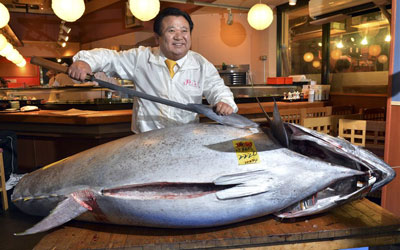
TOKYO: “Sometimes I cry, but only when I'm at home on my own,” says Tetsuya Sakurai, one of the selected few who has paid $6,000 for an intensive and stressful training course to become a sushi chef in Tokyo.
To the untutored, a little ball of rice with a slice of raw fish on top may look like a simple affair.
But students on the twice-yearly course in Tokyo soon learn that for masters of the art, there is so much more to it than meets the eye.
“The best students will take at least two years before they can do this properly,” said teacher Kazuki Shimoyama. “The slowest may take four.”
And before they even get to the stage where they are allowed to combine the delicately formed nigiri (rice balls) with a slice of sashimi, they have to learn how to cut the fish.
For Sakurai, hunched over a fresh mackerel as he slips the razor-sharp knife through its firm flesh, it's a nerve-wracking experience, made all the worse by the presence of three glowering teachers, watching his every move.

“It's very hard,” he tells AFP, a month into his course. “I train at school every day. Cutting the fish is like performing surgery. But what I really don't enjoy is removing the innards from a shellfish. It's really difficult.”
Like his fellow students, Sakurai eagerly answers when their tutor asks if they understand.
“To cut the fillet lengthways, pull the tail and slide the knife along. You follow?” bellows the teacher. “Yes!” the 20 shout in unison.
“Then cut each piece diagonally, making the tail end a little bigger. You follow?”
“Yes!” they reply again.
But when Sakurai did not please his mentor, he will hear things like, “that's your attempt at cutting a mackerel? Terrible. Do it again.”
Students work in silence in a classroom where harsh neon lights glint off steel knives, threatening to expose the tiniest imperfection on the bleach-white clothes they wear.
Sushi rice, perfectly plump Japanese shortgrain into which precisely measured quantities of rice vinegar, salt and sugar are added, is pressed into a large pellet in each student’s hand.
Too much rice and it will be more than a mouthful; too little and it will be overpowered by the fish; too much pressure and it will be hard; too little and the pellet will fall apart.
Not forgetting a delicate smear of wasabi, a fiery green root that is grated into a paste, is applied to the rice and a sliver of fish is placed on top.
“It sounds easy, but it's really hard to make them the way they are supposed to be,” admits a student who gave his surname as Yamanaka. “The teacher makes it look so easy, but it's really difficult.”

If they complete the three-month course run by the restaurant chain Sushi Zanmai (whose boss paid a record of $1.8 million for a single fish in the first auction of the year at Tsukiji market), students will receive a level 5 diploma.
Two years' hard graft in a restaurant and they get their level 4.
Reaching level 1 can take years.
For Sakurai, who spent two decades working as an accountant in the US and in England, the sushi school has been something of a culture shock.
“My teacher is a bit aggressive, it's almost military,” he says.
“It's so different from what you might expect in a Western education system where they praise you when you do something well.”
Here, not being shouted at is the only indication students get that they are making the grade.
“I have two more months,” says Sakurai. “After school I practice in the evenings at home, especially the cutting of shellfish. I cannot do it at all, but I'll get there.”
“There” for Sakurai, is his own sushi bar “in Asia, in Japan, maybe in France.”
“Why not?” he muses.

For teacher Shimoyama, making a proper sushi is not supposed to be easy. It's a vocation which requires a chef to devote his heart for as long as he is in it.
“Chefs gain speed and should strive to achieve the best possible sushi. They should give it their body and soul. And no matter what, they should always smile for customers.”
Even when a chef has completed his diploma and has his own place or his own regular customers, there is still more he can do to perfect his art.
“I have made sushi for 29 years,” said Shimoyama. “And I am still learning.”












































Dear visitor, the comments section is undergoing an overhaul and will return soon.